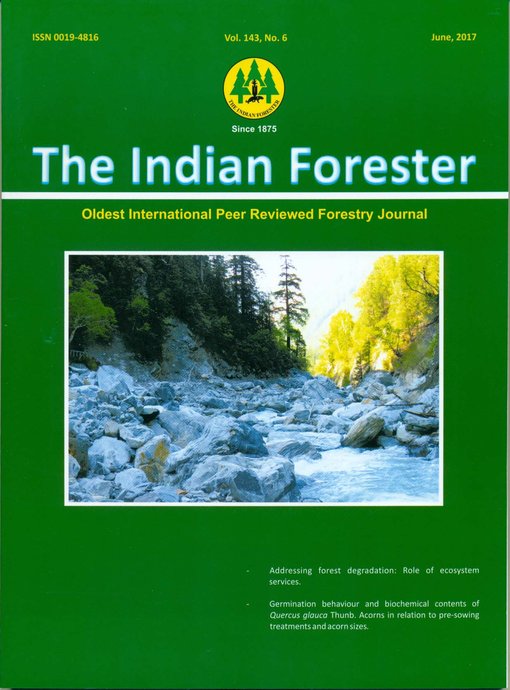Variability of Soil Infiltration under 15 Year Old Plantation in Jabalpur, Central India
DOI:
https://doi.org/10.36808/if/2017/v143i6/115844Keywords:
Soil Infiltration, Cumulative Infiltration, Dalbergia sissoo, Tectona grandis, Terminalia arjuna.Abstract
Rainwater harvesting is the only solution to combat water crises problems of 21st century. Trees are vital to control heavy rainfall and ground water recharge due to its impact on soil infiltration characteristics. Rain water harvesting potential of trees can be explored by standard methods of infiltration tests. Infiltration tests were carried out under the 15 years old plantations of Dalbergia sissoo, Tectona grandis and Terminalia arjuna tree species and grassland. The steady state (7 hr duration) infiltration rate was significantly higher under T.grandis (45 mm hr ) followed by D.sissoo (18 mm-1 hr-1), T.arjuna (8 mm-1 hr-1) and grassland (5 mm hr ). Similarly cumulative depth of water recharged in 7 hours was significantly higher in T.grandis (315 mm) followed by D.sissoo (128 mm), T.arjuna (55 mm) and grassland (34 mm). Among the investigated tree species Tectona grandis was found very much suitable for rain water harvesting.References
Anon. (2001). Infiltration rate of different texture, SARDI (South Australian Research and Development Institute) on website: http://www.sardi.sa.gov.su/
Bharti L., Lee K.H., Isenhart T.B. and Schultz R.C. (2002). Soil water infiltration under crop, pasture and established riparian buffer in mid western USA. Agroforestry Systems56: 249-257.
Bramley H., Hutson J. and Tyerman S.D. (2003). Floodwater infiltration through root channels on a sodic clay floodplain and the influence on a local tree species Eucalyptus largiflorens. Plant Soil, 253:275–286.
Chandler K.R. and Chappell N.A. (2008). Influence of individual oak (Quercus robur) trees on saturated hydraulic conductivity. Forest Ecology and Management, 256:1222-1229.
Gaur M.L. (2003). Characterizing surface infiltration variability in a small natural forest watershed. Indian Forester 129 (3), 341-348.
Johnson M.S. and Lehmann J. (2006). Double-funneling of trees: Stemflow and root-induced preferential flow. Ecoscience, 13:324–333.
Matthew T., Murray M. and Danny T. (2009). Infiltration characteristics of soils under forestry and agriculture in the upper Waikato catchment. Environment Waikato Technical Report 2009/18.
Nazir T. and Sharma C.M. (2015). Rate of infiltration under different forest cover of Garhwal Himalaya. Indian Forester, 141(9): 930-940.
NWP (2012). National Water Policy Ministry of Water Resources, Govt. of India.
Patel R.B. and Patel K.B. (2003). Future research needs and action plan to Combat water problems of India. Agricultural Engineering Today, 27(1-2):29-34.
Sahu M.L. (2006). Evaluation of differential responses of selected farm forestry Trees in relation to stemflow, throughfall and interception losses. Ph.D. Thesis, JNKVV, Jabalpur. MP. 136p.
Sahu M.L. (2007). Rainfall harvesting through trees in rainfed ecosystem. In: Abstracts. International Conference on Sustainable Agriculture for
Food, Bio-energy and Livelihood Security, February 14-16, 2007, JNKVV Jabalpur MP: 427-428.
Simcock R. (2006). Stormwater and erosion in the urbanizing Acacia heights catchment, Taupo. Landcare research contract report LC0607/034. Taupo district council, Taupo.
Tian Y.Q., McDowel R., Yu Q., Shealth G.W., Carlson W.T. and Gong P. (2006). Modelling to analyse the impacts of animal treading on soil infiltration. Hydrological Processes, 21: 1106-1114.
Wondzell S.M. and King J.G. (2003). Post fire erosional processes in the Pacific Northwest and rocky mountain region. Forest Ecology and Management, 178 (1): 75-87.
Downloads
Downloads
Published
How to Cite
Issue
Section
License
Unless otherwise stated, copyright or similar rights in all materials presented on the site, including graphical images, are owned by Indian Forester.





